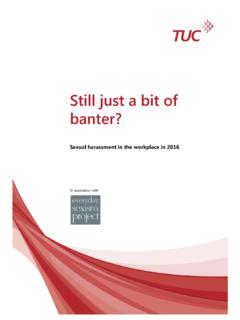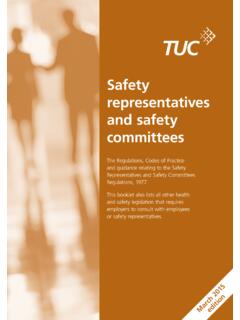Transcription of Dyslexia in the workplace - TUC
1 Dyslexia in the workplaceA TUC guideThird editionAbout the Hagan has been a trade union member for more than 38 years and has worked as a senior personnel manager and head of management consultancy in the public and private qualified to teach adults with Dyslexia at University College London in 1991, he now specialises in helping dyslexic employees and their employers identify workplace adjustments to mitigate the effects of Dyslexia in the workplace , and in providing career advice, mentoring and training for adults with Dyslexia and is happy to provide a free initial consultation to trade union members/representatives.
2 His contact details are:Tel: 020 8348 7110 Email: Web: written by Brian Hagan for the TUC in 2005, revised in spring 2008, and substantially updated and revised in 2013/4. The contributions of Dr Sylvia Moody, Katherine Kindersley, Melanie Jameson, David Edwards, Andy Fell and Margaret Malpas are gratefully booklet has been published in accordance with British Dyslexia Association in the workplace 4 Part role of the union 5 Section in the workplace : the issues 6 Section in the workplace .
3 A mentoring role for representatives 8 Part a working knowledge of Dyslexia and its major effects 11 Section whether an employee is dyslexic 13 Section a diagnostic assessment 14 Section is a workplace needs assessment (WNA)? 16 Section a workplace needs assessment (WNA) 20 Section a programme of adjustments 18 Section workplace policies and procedures more Dyslexia -friendly 22 Part Equality Act 2010 26 Section law and good practice in implementing reasonable adjustments (RAs) 29 Part 38 Section.
4 Promoting awareness information 404 Dyslexia in the originally wrote this guide in 2005, principally for trade union members and their representatives. It was revised in 2008 in light of the Disability Discrimination Act 2005, new case law and personal experience of good practice. Much has changed since that revision including: the introduction of the Equality Act 2010 (EA) which replaced previous anti-discrimination laws with a single Act; a sharpening focus on Dyslexia at work by major organisations including trade unions and employers, educationalists, government agencies, and Dyslexia charities including the British Dyslexia Association (BDA) and Dyslexia Action (DA).
5 The continuing development of good practice in workplace assessment, consultancy and training in my own practice and that of , whilst this edition continues to help foster a fuller understanding of Dyslexia and its effects on employees, it also introduces a framework for adopting a more proactive approach through negotiating policy guidelines to promote more Dyslexia -friendly workplaces; it does this alongside a recognition that in the more difficult labour market conditions we face, this may not always be possible; this guide also provides updated and detailed guidance on the hard business of supporting dyslexic members in practical and pragmatic in the workplace 5 Part A.
6 Section role of the union. Union representatives need to be aware of the full range of workplace problems and solutions related to Dyslexia , and be able to empathise with their dyslexic members. They should focus on communicating to colleagues and employers:1. That reasonable adjustments (RAs) can frequently turn round apparently unsatisfactory performance, and that government funding under the Access to Work Scheme ( ) is usually available to fund adjustments. 2. That the very real psychological and social reasons behind some dyslexic employees apparently difficult behaviour are frequently the result of many years of harsh criticism and discrimination.
7 For many dyslexic employees the recognition that they are dyslexic is the first step on the road to reclaiming their lives. In this guide we explain: the legal framework for protecting dyslexic members from unfair and discriminatory treatment, if consensus and negotiations fail; what kind of working environment and practices will be difficult for someone with Dyslexia ; what kind of adjustments should be negotiated with the employer to put this right. 6 Dyslexia in the workplacePart A. Section in the workplace : the British Dyslexia Association (BDA) estimates that between four and ten per cent of the population is dyslexic, with four per cent of the population seriously affected and six per cent experiencing less serious difficulties a figure supported by the government s own research.
8 This means that up to million workers may be affected. All employers with the exception of the Armed Forces are covered by the provisions of the Equality the last ten years many trade unions and employers have developed a more satisfactory understanding of Dyslexia one that goes beyond earlier perceptions of it being restricted to general literacy problems. Dyslexic difficulties frequently extend beyond literacy difficulties to include weaknesses in short-term memory, information processing and perceptual, spatial and motor skills.
9 These difficulties can singly, or in combination, cause problems with performance, organisation and time management, which in turn can cause or exacerbate mental health difficulties; this latter link remains largely, and worryingly unaddressed in the addition, whilst a professionally conducted workplace needs assessment and recommended reasonable adjustments can mitigate many of these difficulties, large numbers of dyslexic employees remain undiagnosed. Even with a diagnosis, many employees are understandably reluctant to disclose their disability and its impact in harsh labour market conditions, or whilst employed in an organisation which they fear will be unsympathetic to their overview of the major issues that adversely affect dyslexic British Dyslexia Association, the TUC and many leading dyslexic practitioners have reported that.
10 Many dyslexic employees experience disciplinary and misconduct-led approaches for problems which are disability-related. High levels of bullying, stress and mental health problems arise from misunderstanding and poor management of Dyslexia and dyspraxia at in the workplace 7 There is limited understanding of reasonable adjustments, and what does and doesn t work, in workplace negotiations to resolve these issues. Whilst 80 per cent of employees asked in a recent TUC national survey were aware that some colleagues might be dyslexic, unions typically find out about related problems via disciplinaries and grievances.














